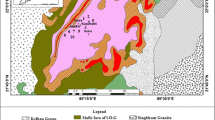Abstract
New evidence on the genesis of the red beryl from Utah (U.S.A.) is presented. By means of electron microscopy and microanalysis solid inclusions of beryl, quartz, K-feldspar, bixbyite and hematite were studied on many different sections cut parallel and perpendicular to thec axis. Data provide evidence of sharp compositional variations between protogenetic and syngenetic phases. The K-feldspar inclusions show corroded rims wherefrom potassium diffused into the surrounding beryl. The hexagonal textures of beryl around K-feldspar confirm that dissolving of this phase and of the host matrix gives rise to the best conditions for the growth of well-shaped crystals in the hard rock. Bixbyite inclusions belong to two crystallization stages, showing high Fe in the relics, and high Mn in the sharp cubic grains. Muan and Somiya’s (1962) diagram allows to evaluate a temperature of crystallization lower than 950°C for the earlier phase (55-52wt% Fe2O3). After fractionation due to metasomatic processes, the temperature of final crystallization is about 600°C as indicated by the Mn-rich phase (31-39wt% Fe2O3).
Riassunto
Nella presenteNota vengono presentate nuove ipotesi sulla genesi del berillo rosso dell’Utah (U.S.A.). Diverse sezioni di berillo tagliate perpendicolarmente o parallelamente alla direzione dell’assec sono state studiate per mezzo della microscopia elettronica e della microanalisi a raggi X. In particolare sono state analizzate le inclusioni solide di berillo, quarzo, feldspato potassico, bixbyite ed ematite rinvenute nelle diverse sezioni. I dati ottenuti mettono in evidenza importanti variazioni composizionali tra le fasi protogenetiche e singenetiche. Il feldspato potassico mostra bordi di reazione che sottolineano il suo disequilibrio. La mappa ai raggi X del potassio indica un notevole arricchimento di questo elemento nel berillo circostante, mentre quella con elettroni retroriflessi evidenzia tessiture esagonali di berillo di neoformazione attorno al feldspato potassico, dovuto ai processi metasomatici che interessano matrice e feldspati creando così le condizioni ideali per lo sviluppo di cristalli ben formati. Le inclusioni di bixbyite appartengono a due fasi di cristallizzazione caratterizzate da maggiori tenori in Fe nei relitti, che viene sostituito dal Mn nei grani perfettamente idiomorfi. Il diagramma di Muan e Somiya (1962) ha permesso di individuare un intervallo di temperatura di cristallizzazione compreso tra 950°C per le fasi protogenetiche (55-52% Fe2O3) e 600°C per le fasi singenetiche (31-39% Fe2O3).
Similar content being viewed by others
References
Aurisicchio C, Fioravanti G. C, Grubessi O. andZanazzi P. F., 1988.Reappraisal of the crystal chemistry of beryl. Am. Mineral., 73: 826–837.
Beus A., 1983.On the possible mechanism of formation of euhedral crystals in metasomatic processes. Bull. Mineral., 106: 411–415.
Burt D. M., Sheridan M. F., Bikun J. V. andChristiansen E. H., 1982.Topaz rhyolites-Distribution, origin, and significance for exploration. Econom. Geol., 77: 1818–1836.
de Villiers J. P. andBusech P. R.., 1990.Stacking variations and non-stoichiometry in the bixbyite-braunite polysometic mineral group. 15th IMA Congress, 1: 303–304.
Flamini A., Gastaldi L., Grubessi O. eViticoli S., 1983.Sulle caratteristiche particolari del berillo rosso dell’Utah. La Gemmologia, Milano, 9: 12–20.
Hillebrand W. F., 1905.Red benyl from Utah. Am. J. Sci., 4: 330–331.
Lufkin J. L., 1976.Oxide minerals in miarolitic rhyolite, Black Range, New Mexico. Am. Mineral., 61: 425–430.
Mason B., 1944.The system FeO - MnO: some comments on the name bixbyite, sitaparite and partridgeite. Am. Mineral., 29: 66–69.
Muan A. andSomiya S., 1961.Stability relation of iron and manganese minerals: phase equilibria at liquids temperature in the system iron oxide-manganese oxide-silica in air. Am. Mineral., 46: 364–378.
Muan A. andSomiya S., 1962.The system iron oxide-manganese oxide in air. Am. J. Sci., 260: 230–234.
Nassau K. andWood D. L., 1968.An examination of red beryl from Utah. Am. Mineral, 53: 801–806.
Patton H. B., 1908.Topaz bearing rhyolite of the Thomas Range, Utah. Geol. Soc. America Bull., 19: 177–192.
Ream L. R., 1979.The Thomas Range, Wah Wah Mts. (Western Utah). Mineral. Record, 10 n. 5: 261–278.
Shaub B. M., 1937.Contemporary crystallization of beryl and albite vs. replacement. Am. Mineral., 22: 1045–1051.
Shigley J. E. andFoord E. E., 1984.Gem-quality red beryl from the Wah Wah Mts., Utah. Gem and Gemology, 4: 208–221.
Staatz M. M. andCarr W. J., 1964.Geology and mineral deposits of the Thomas and Dugway Range,Utah. U.S. Geol. Survey Prof. Paper., 415.
Staatz M. M., Griffitts W. R. andBarnett P. R., 1965.Differences in the minor element composition of beryl in various environments. Am. Mineral, 50: 1783–1795.
Author information
Authors and Affiliations
Additional information
Nella seduta del 14 giugno 1990.
Rights and permissions
About this article
Cite this article
Aurisicchio, C., Fioravanti, G., Grubessi, O. et al. Genesis and growth of the red beryl from Utah (U.S.A.). Rend. Fis. Acc. Lincei 1, 393–404 (1990). https://doi.org/10.1007/BF03001774
Issue Date:
DOI: https://doi.org/10.1007/BF03001774




